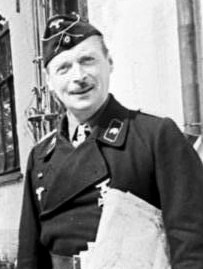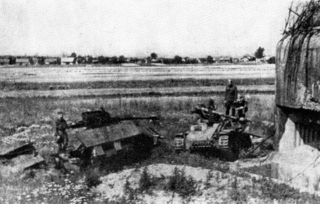Army Group Centre was the name of two distinct strategic German Army Groups that fought on the Eastern Front in World War II. The first Army Group Centre was created on 22 June 1941, as one of three German Army formations assigned to the invasion of the Soviet Union. On 25 January 1945, after it was encircled in the Königsberg pocket, Army Group Centre was renamed Army Group North, and Army Group A became Army Group Centre. The latter formation retained its name until the end of the war in Europe.

The Battle of Korsun–Cherkasy, or the battle of the Korsun–Cherkasy pocket, was a World War II battle fought from 24 January to 16 February 1944 in the course of the Soviet Dnieper–Carpathian offensive in Ukraine following the Korsun–Shevchenkovsky offensive. In the battle, the 1st and 2nd Ukrainian Fronts, commanded, respectively, by Nikolai Vatutin and Ivan Konev, encircled German forces of Army Group South in a pocket near the Dnieper River. During weeks of fighting, the two Red Army Fronts tried to eradicate the pocket. The encircled German units attempted a breakout in coordination with a relief attempt by other German forces, resulting in heavy casualties, estimates of which vary.

The Prague offensive was the last major military operation of World War II in Europe. The offensive was fought on the Eastern Front from 6 May to 11 May 1945. Fought concurrently with the Prague uprising, the offensive significantly helped the liberation of Czechoslovakia in 1945. The offensive was one of the last engagements of World War II in Europe and continued after Nazi Germany's unconditional capitulation on 8 May.

The Vistula–Oder offensive was a Red Army operation on the Eastern Front in the European theatre of World War II in January 1945. The army made a major advance into German-held territory, capturing Kraków, Warsaw and Poznań. The Red Army had built up their strength around a number of key bridgeheads, with two fronts commanded by Marshal Georgy Zhukov and Marshal Ivan Konev. Against them, the German Army Group A, led by Colonel-General Josef Harpe, was outnumbered five to one. Within days, German commandants evacuated the concentration camps, sending the prisoners on their death marches to the west, where ethnic Germans also started fleeing. In a little over two weeks, the Red Army had advanced 300 miles (483 km) from the Vistula to the Oder, only 43 miles (69 km) from Berlin, which was undefended. However, Zhukov called a halt, owing to continued German resistance on his northern flank (Pomerania), and the advance on Berlin had to be delayed until April.
The 1st Panzer Army was a German tank army that was a large armoured formation of the Wehrmacht during World War II.

The Battle of the Seelow Heights was part of the Berlin Strategic Offensive Operation. A pitched battle, it was one of the last assaults on large entrenched defensive positions of the Second World War. It was fought over three days, from 16–19 April 1945. Close to 1,000,000 Soviet soldiers of the 1st Belorussian Front, commanded by Marshal Georgi Zhukov, attacked the position known as the "Gates of Berlin". They were opposed by about 110,000 soldiers of the German 9th Army, commanded by General Theodor Busse, as part of the Army Group Vistula.

Hyazinth Graf Strachwitz was a German officer of aristocratic descent in the Wehrmacht during World War II. He was a recipient of the Knight's Cross of the Iron Cross with Oak Leaves, Swords and Diamonds.

The Lvov–Sandomierz offensive or Lvov–Sandomierz strategic offensive operation was a major Red Army operation to force the German troops from Ukraine and Eastern Poland. Launched in mid-July 1944, the operation was successfully completed by the end of August.

The Battle of the Oder–Neisse is the German name for the initial (operational) phase of one of the last two strategic offensives conducted by the Red Army in the Campaign in Central Europe during World War II. Its initial breakthrough phase was fought over four days, from 16 April until 19 April 1945, within the larger context of the Battle of Berlin. The Soviet military planners divide the frontal and pincer phases of the operation, named Berlin Strategic Offensive Operation into:

The siege of Breslau, also known as the Battle of Breslau, was a three-month-long siege of the city of Breslau in Lower Silesia, Germany, lasting to the end of World War II in Europe. From 13 February 1945 to 6 May 1945, German troops in Breslau were besieged by the Soviet forces which encircled the city as part of the Lower Silesian Offensive Operation. The German garrison's surrender on 6 May was followed by the surrender of all German forces two days after the battle.

The Battle of Bautzen was one of the last battles of the Eastern Front during World War II. It was fought on the extreme southern flank of the Spremberg-Torgau Offensive, seeing days of pitched street fighting between forces of the Polish Second Army under elements of the Soviet 52nd Army and 5th Guards Army on one side and elements of German Army Group Center in the form of the remnants of the 4th Panzer and 17th armies on the other.

The East Pomeranian strategic offensive operation was an offensive by the Soviet Red Army against the German Wehrmacht on the Eastern Front. It took place in Pomerania and West Prussia from 10 February – 4 April 1945.
Operation Solstice, also known as Unternehmen Husarenritt or the Stargard tank battle, was one of the last German armoured offensive operations on the Eastern Front in World War II.
The Lower Silesian offensive was a Soviet offensive on the Eastern Front of World War II in 1945, involving forces of the 1st Ukrainian Front under Marshal Ivan Konev. It cleared German troops from much of Lower Silesia and besieged a large German force in the provincial capital, Breslau. The offensive began on February 8 and continued until February 24, when the Soviets ceased their offensive having captured a small bridgehead across the Neisse River near Forst. The offensive directly succeeded the Vistula–Oder offensive, in which Konev's troops had driven the German Army Group A from Poland, liberating Kraków and taking bridgeheads over the Oder.

The Riga offensive was part of the larger Baltic offensive on the Eastern Front during World War II. It took place late in 1944, and drove German forces from the city of Riga.

The Nikopol–Krivoi Rog offensive was an offensive by the Red Army's 3rd Ukrainian Front and elements of the 4th Ukrainian Front against the German 6th Army in the area of Nikopol and Krivoi Rog in Dnipropetrovsk Oblast in central Ukraine between 30 January and 29 February 1944. It took place on the Eastern Front of World War II and was part of the wider Dnieper–Carpathian offensive, a Soviet attack against Army Group South to retake the rest of Ukraine that fell to Germany in 1941.

The Bratislava–Brno offensive was an offensive conducted by the Red Army in western Slovakia and south Moravia towards the end of World War II. The offensive was held between 25 March and 5 May 1945 using the forces of the 2nd Ukrainian Front to capture the capital of Slovakia, Bratislava, and the capital of Moravia, Brno.
The 16th Guards Tank Division was a tank division of the Soviet Army and later the Russian Ground Forces.
The 391st Rifle Division was raised in 1941 as an infantry division of the Red Army, and served for the duration of the Great Patriotic War in that role. It began forming in August 1941, in the Central Asian Military District. It was first assigned to Southwestern Front but on its arrival it was seen to be far from combat-ready and so was moved north to the Moscow area for further training. It was finally assigned to the 3rd Shock Army in Kalinin Front and took part in the battle for the Kholm Pocket. Following this the division was moved to 1st Shock Army and took part in the dismal fighting for the Demyansk salient until it was finally evacuated by the German forces in March, 1943. The division moved on into the gradual advance across the Baltic states through 1943 and 1944, winning a battle honor along the way, until February, 1945, when it was transferred with its 93rd Rifle Corps to 1st Ukrainian Front as part of 59th Army. In the last weeks of the war the 391st was awarded the Order of the Red Banner for its service in Upper Silesia, and ended the war advancing on Prague, but despite its distinguished record it was selected as one of the many divisions to be disbanded during the summer of 1945.

The Moravia–Ostrava offensive operation was an offensive by the Red Army during World War II that lasted from March 10 to May 6, 1945, and was the Soviet conquest of present-day Eastern Czech Republic.















